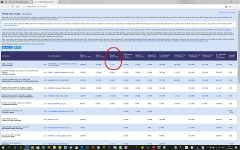You, Bill, are the perfect candidate for my statement.
How so?
It is also the breeding ground for almost all significant artists, and has been since 1967 when the FCC dictated that stations with both AM and FM licenses create unique programming for the FM broadcast.
I moved to Boston in 1968 and got to observe much of this. By 1981 college radio was totally out there, in fact some of the old DJ's will deny what they played. Around that time the FCC exercised no control over the content below 92MHz and I have off air cassettes to prove it.
Yes, so one of the scopes that does say 10x oversampling. I have a Tek MDO3024 200 MHz that does 2.5 GS/s (so 12x if I understand it correctly). Seems it should be ok but. Maybe a better example is an audio DAC fed with white noise. I guess the answer is up until Fs/2 it’s ok but after that, aliasing aside, it falls off the rails.
Yeah, you're probably right. The MDO3024 is a real-time scope, not an equivalent-time sampling scope. What JN describes is correct for a sampling scope.
The 12x oversampling is only for the software limited 200 MHz version, note that the series goes up to 1 GHz bandwidth @ 5 GSPS.
QA400
Hi all,
I have one of the (obsolete) QA400s, is there a repository of test plugins for it anywhere? It is good for basic stuff, but I'd like more versatility.
Thanks!
Howie
Hi all,
I have one of the (obsolete) QA400s, is there a repository of test plugins for it anywhere? It is good for basic stuff, but I'd like more versatility.
Thanks!
Howie
Hi all,
I have one of the (obsolete) QA400s, is there a repository of test plugins for it anywhere? It is good for basic stuff, but I'd like more versatility.
Thanks!
Howie
See forum under Equipment and Tools.....QuantAsylum QA400 and QA401.
They would know.
THx-RNMarsh
-3dB @ 16kHz, -17dB @ 20kHz, -24.4dB @ 22.05kHz but as Scott suggested the sexy spec is the benign group delay.
Who knows, even RNM has given up to the idea that the freq cut off isn’t everything.
George
Of course, but the group delay benefit would still be preserved even if you'd scale the networks for a slightly higher cut-off frequency; it is always a compromise between bandwidth and risk of aliasing in a 44.1 kHz system without oversampling ....
At the end it depends on the music genre(s), recording technique (did someone say microphone bandwidth? 🙂 ) and ones own listening impressions.
Electroj, you may not like the outcome of this test, but I think it is rather well done and in line with what other investigations found.
<snip>
I'm still interested to know why you think this experiment (Meyer/Moran) was "well done". 😉
Thanks, Hans!
Btw, my workstation complains that files are at 88.2 , not 96 kHz 😉
Thanks Elektroj, you are right, I didn't notice.
I took it from the test bench site as being a 96/24, see image below.
But it happens to be 88.2/24, still well above the 80Khz that JC and Richard are propagating as the minimum Fs, so for this test it won't hurt.
Hans
Attachments
Last edited:
What studies are there into the required bandwidth for "accurate" rendition?At the end it depends on the music genre(s), recording technique (did someone say microphone bandwidth? 🙂 ) and ones own listening impressions.
What studies are there into the required bandwidth for "accurate" rendition?
Those that we already had mentioned in the recent couple of years with still inconclusive results.
But, as gpapag was looking for an anti-aliasing filter (if I'm not mistaken) he probably is able to decide for himself what kind of compromise fits his purposes best.
What studies are there into the required bandwidth for "accurate" rendition?
Stereophile has one in almost every number 😉
//
Jakob, it would be nice to also have your opinion on the three test files that I prepared. When I have correctly understood your postings, you also seem to prefer a higher Fs and maybe 24 instead of 16 bit.Those that we already had mentioned in the recent couple of years with still inconclusive results.
But, as gpapag was looking for an anti-aliasing filter (if I'm not mistaken) he probably is able to decide for himself what kind of compromise fits his purposes best.
Hans
Thanks Elektroj, you are right, I didn't notice.
I took it from the test bench site as being a 96/24, see image below.
But it happens to be 88.2/24, still well above the 80Khz that JC and Richard are propagating as the minimum Fs, so for this test it won't hurt.
Hans
96 is OK. Are you going to do listening test at an even higher sampling rate? How do files compare at 192KHz ?
Thats the rate I suggest is best (or higher).... the point of diminishing returns.
THx-RNMarsh
Last edited:
Sorry to ask you again Hans, but do you think my system (the digital bit 😉) is up to the job, it seems to be?
Jakob, it would be nice to also have your opinion on the three test files that I prepared.
Hans
What is file "A".
-RNM
Sorry to ask you again Hans, but do you think my system (the digital bit 😉) is up to the job, it seems to be?
Why not, this is what you use so this is your reference.
And when you don’t hear differences with your gear, it’s telling that you don’t have to spend extra money on Hi-Res.
Hans
What is file "A".
-RNM
I’ll wait telling until I have at least 5 responses, now at 3 still 2 to go.
Hans
- Home
- Member Areas
- The Lounge
- The Black Hole......
